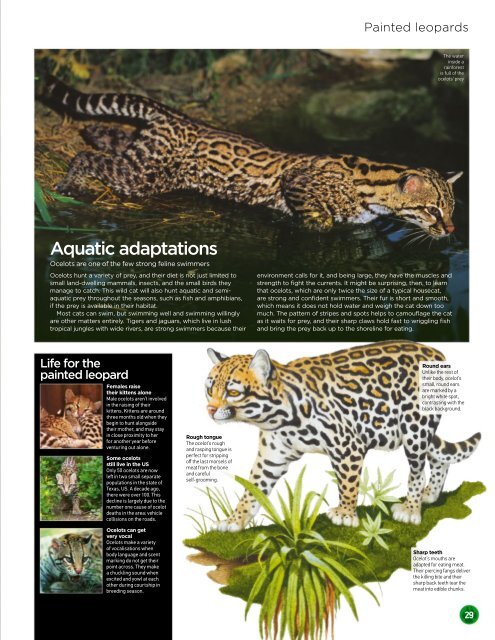World_of_Animals_Issue_46_2017
Create successful ePaper yourself
Turn your PDF publications into a flip-book with our unique Google optimized e-Paper software.
Painted leopards<br />
The water<br />
inside a<br />
rainforest<br />
is full <strong>of</strong> the<br />
ocelots’ prey<br />
Aquatic adaptations<br />
Ocelots are one <strong>of</strong> the few strong feline swimmers<br />
Ocelots hunt a variety <strong>of</strong> prey, and their diet is not just limited to<br />
small land-dwelling mammals, insects, and the small birds they<br />
manage to catch. This wild cat will also hunt aquatic and semiaquatic<br />
prey throughout the seasons, such as fish and amphibians,<br />
if the prey is available in their habitat.<br />
Most cats can swim, but swimming well and swimming willingly<br />
are other matters entirely. Tigers and jaguars, which live in lush<br />
tropical jungles with wide rivers, are strong swimmers because their<br />
environment calls for it, and being large, they have the muscles and<br />
strength to fight the currents. It might be surprising, then, to learn<br />
that ocelots, which are only twice the size <strong>of</strong> a typical housecat,<br />
are strong and confident swimmers. Their fur is short and smooth,<br />
which means it does not hold water and weigh the cat down too<br />
much. The pattern <strong>of</strong> stripes and spots helps to camouflage the cat<br />
as it waits for prey, and their sharp claws hold fast to wriggling fish<br />
and bring the prey back up to the shoreline for eating.<br />
Life for the<br />
painted leopard<br />
Females raise<br />
their kittens alone<br />
Male ocelots aren’t involved<br />
in the raising <strong>of</strong> their<br />
kittens. Kittens are around<br />
three months old when they<br />
begin to hunt alongside<br />
their mother, and may stay<br />
in close proximity to her<br />
for another year before<br />
venturing out alone.<br />
Some ocelots<br />
still live in the US<br />
Only 50 ocelots are now<br />
left in two small separate<br />
populations in the state <strong>of</strong><br />
Texas, US. A decade ago,<br />
there were over 100. This<br />
decline is largely due to the<br />
number one cause <strong>of</strong> ocelot<br />
deaths in the area: vehicle<br />
collisions on the roads.<br />
Ocelots can get<br />
very vocal<br />
Ocelots make a variety<br />
<strong>of</strong> vocalisations when<br />
body language and scent<br />
marking do not get their<br />
point across. They make<br />
a chuckling sound when<br />
excited and yowl at each<br />
other during courtship in<br />
breeding season.<br />
Rough tongue<br />
The ocelot’s rough<br />
and rasping tongue is<br />
perfect for stripping<br />
<strong>of</strong>f the last morsels <strong>of</strong><br />
meat from the bone<br />
and careful<br />
self-grooming.<br />
Round ears<br />
Unlike the rest <strong>of</strong><br />
their body, ocelot’s<br />
small, round ears<br />
are marked by a<br />
bright white spot,<br />
contrasting with the<br />
black background.<br />
Sharp teeth<br />
Ocelot’s mouths are<br />
adapted for eating meat.<br />
Their piercing fangs deliver<br />
the killing bite and their<br />
sharp back teeth tear the<br />
meat into edible chunks.<br />
29


















